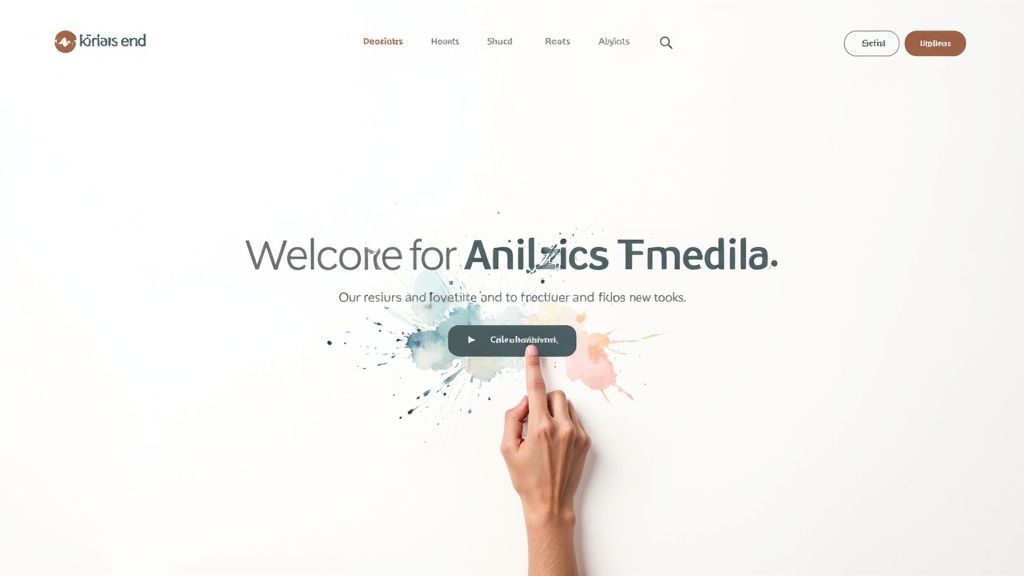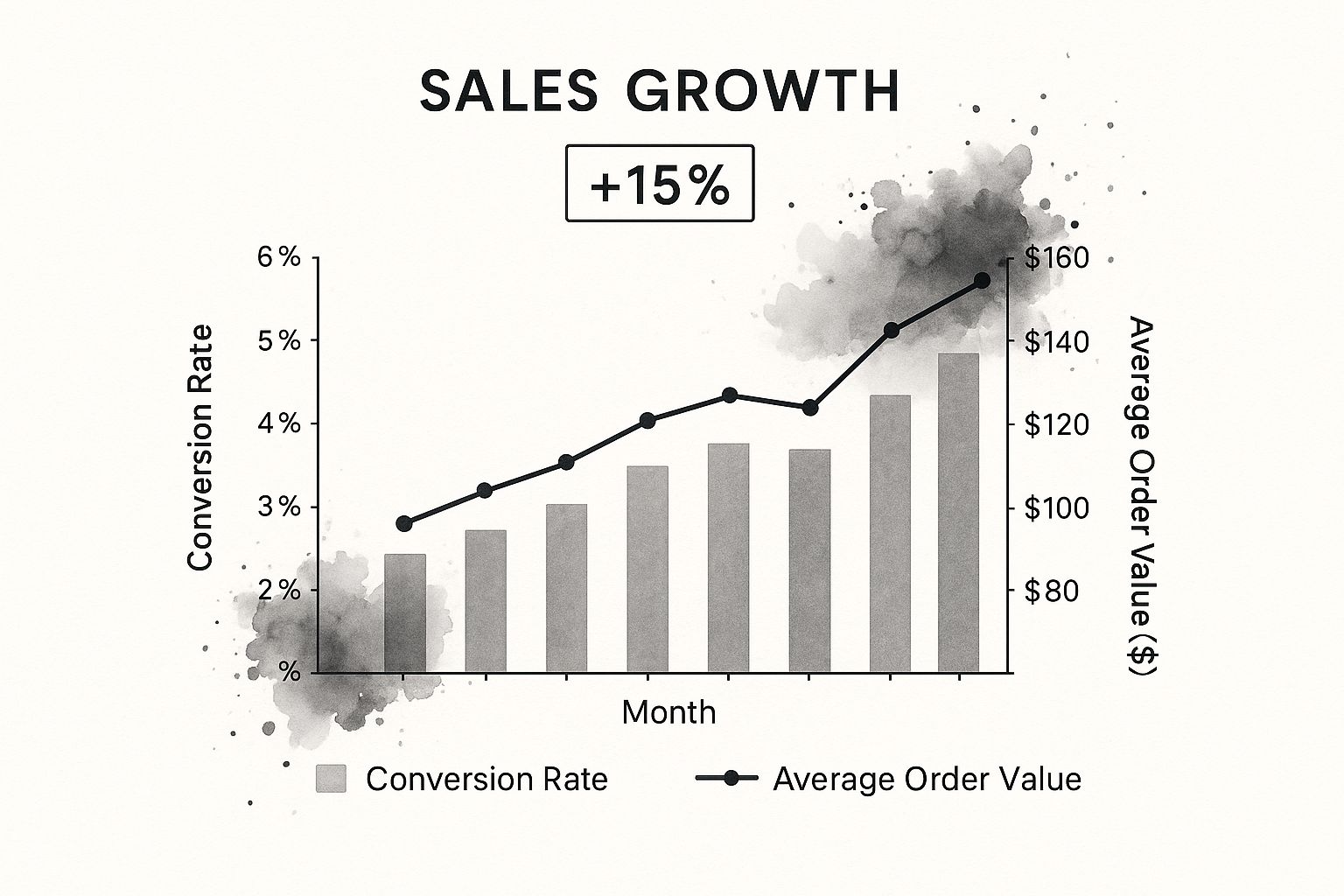Before you pour a single dollar into advertising, let's talk about your digital foundation. It's the critical, behind-the-scenes work that ensures every ad dollar you spend delivers maximum impact. Launching a flashy ad campaign that directs users to a confusing or broken website is like hosting a grand opening at a construction site—a guaranteed way to waste time and money. Real, sustainable growth starts by getting the fundamentals right.
This guide isn't about chasing fleeting trends. It's about building the non-negotiable elements that turn website visitors into loyal, paying customers and learning how to increase online sales predictably.
First, Solidify Your Digital Foundation
Start with a Digital Presence Audit
First things first: take an honest, unflinching look at your current digital assets. This means auditing your website, social media profiles, and any existing ad accounts.
It's time to ask some critical questions:
- Website Performance: Is your site fast? More importantly, is it effortless to use on a smartphone?
- Message Clarity: Can a new visitor understand what you do and why you're the best choice within five seconds of landing on your homepage?
- Conversion Points: Are your calls-to-action (CTAs) clear and compelling? Do they guide visitors toward the next step?
This audit is about identifying what's working and, just as crucially, what's quietly draining your budget. You need to patch the leaks in your bucket before you start filling it with high-intent traffic.
Define Your Unique Selling Proposition (USP)
Your Unique Selling Proposition is the core of your marketing message. It’s the concise, compelling answer to a customer's fundamental question: "Why should I choose you over all the other options?"
A powerful USP isn't a generic slogan; it's a specific, benefit-driven promise that sets you apart from the competition.
A well-defined USP should be woven into your website headline, ad copy, and social media bio—everywhere your brand appears. It’s the consistent promise that builds recognition and trust.
For instance, a local realtor in Boca Raton could shift from a bland "I sell homes" to a much stronger USP: "I help families find their forever homes in top-rated school districts in under 30 days." The difference is clear: it's specific, benefit-driven, and memorable.
Prioritize a Mobile-First Experience
I can't overstate this: your website must perform flawlessly on a mobile phone.
Imagine a local service provider in Miami. Many of their leads come from homeowners searching on their phones during a lunch break. If that site is slow, clunky, or requires pinching and zooming, those potential customers are gone in an instant.
The data confirms this unequivocally. By 2025, global eCommerce sales are projected to reach $8.3 trillion, with over 70% of those sales expected to occur on a mobile device. A seamless mobile experience is no longer a "nice-to-have"—it's the price of entry. To dig deeper, you can explore more about these eCommerce trends and their impact on online payments.
Set Up Essential Analytics from Day One
You can't improve what you don't measure. Setting up analytics properly from the beginning is non-negotiable for any business serious about growth.
This means moving beyond vanity metrics like page views and "likes," which don't contribute to your bottom line. Instead, you need to track the numbers that directly impact revenue:
- Conversion Rate: What percentage of visitors take your desired action (e.g., make a purchase, fill out a form)?
- Customer Lifetime Value (CLV): What is a single customer worth to your business over time?
- Cost Per Acquisition (CPA): How much are you spending to acquire one new customer?
Tracking these core metrics is the only way to gain the real-world insights needed to make smart, data-driven decisions on how to increase online sales for the long term.
Before moving on to high-impact ads, let's summarize these foundational elements. Getting them right is the prerequisite for any successful online sales strategy.
Core Foundational Elements for Sales Growth
| Component | Why It's Critical | Actionable First Step |
|---|---|---|
| Digital Presence Audit | Identifies weak spots before you spend on ads. | Test your website's speed with Google PageSpeed Insights and check mobile usability. |
| Unique Selling Prop (USP) | Clearly communicates your value and differentiates you. | Brainstorm one specific, benefit-driven sentence answering "Why should they choose me?" |
| Mobile-First Experience | The majority of online traffic and sales happen on mobile. | Navigate your entire purchase process on a smartphone. Note any friction points. |
| Essential Analytics | Provides the data for smart, profitable marketing decisions. | Install Google Analytics and set up at least one key conversion goal (e.g., a "thank you" page). |
With this foundation in place, you're no longer guessing. You're building a predictable, scalable machine for generating online sales. Now, you’re ready to drive traffic.
How to Increase Online Sales with Paid Advertising

A solid digital foundation is essential, but it won't generate sales on its own. To truly scale, you need to fuel your business with a constant stream of qualified traffic. Paid advertising on platforms like Google and Meta is the most direct path to connecting with people already looking for what you offer.
The goal isn't just to get clicks; it's about attracting high-intent visitors—the people ready to make a purchase. This distinction separates wasted ad spend from a profitable investment in your company's future.
Master Your Audience Segmentation
The secret to successful paid advertising isn't a massive budget; it's precision. You must get your message in front of the right people at the right moment. Fortunately, both Google and Meta offer powerful tools to do just that.
Think of it as having a one-on-one conversation with your ideal customer, not shouting into a crowded stadium.
-
Google Local Service Ads: For a local service provider, like a realtor in Boca Raton, this is a game-changer. These ads appear at the very top of Google search results, connecting you instantly with people searching for "realtor near me" at their highest point of intent.
-
Meta Lookalike Audiences: This is one of the most potent tools in a marketer's arsenal. Upload a list of your best customers, and Meta's algorithm finds new users with similar behaviors and interests. It’s like creating a clone army of your ideal client.
Craft Ad Copy and Visuals That Convert
Once you’ve targeted your audience, you need to grab their attention and inspire action. Your ad is often the first interaction a potential customer has with your brand, so make it count.
Your ad copy must speak directly to a specific pain point or desire. Keep it clear, concise, and focused on the customer's benefit, not just your features.
A common mistake is writing ad copy that talks about the business instead of to the customer. Frame your message around solving their problem. For example, change "We Are an Award-Winning Brokerage" to "Find Your Dream Home Faster with Our Expert Local Agents."
Visuals are equally important, especially on platforms like Instagram and Facebook. Your image or video must be a "scroll-stopper"—high-quality, eye-catching, and relevant to your message. Test different formats, like a short video testimonial or a crisp product shot. This focused approach is a core part of learning how to increase online sales through paid advertising.
Start Lean and Scale With Data
Many business owners hesitate with paid advertising, believing they need a huge budget. The truth is, you should start small. A lean, test-driven approach is the smartest way to use your marketing dollars.
Set a modest initial budget to run tests and gather data. You’ll quickly learn:
- Which audiences respond best to your ads.
- Which headlines get the most clicks.
- Which images or videos drive higher engagement.
- Which landing pages turn visitors into leads or sales.
Once you find a winning combination, you can confidently increase your ad spend. This data-first process removes guesswork and allows you to scale intelligently. For more insights on building a complete digital marketing plan, explore the topics on the DigitalAdvertisingDirect blog.
Optimizing Your Funnel to Maximize Conversions
Getting targeted traffic to your site is a victory, but it's only half the battle. The real work begins when a visitor lands on your page. This is where you convert interest into a sale. An unoptimized funnel is the silent killer of ad campaigns, as businesses pay to send traffic to a clunky or confusing website.
By auditing and fine-tuning each stage of your funnel, you can plug these costly leaks and dramatically increase online sales.
Crafting High-Converting Landing Pages
Think of your landing page as the handshake after the ad click. Its sole job is to convert, which demands unwavering focus. The best landing pages are built around a single, clear call-to-action (CTA).
If your page asks visitors to "Buy Now," "Sign Up," and "Follow Us," you're creating decision paralysis. Dedicate the entire page to one goal. For example, a realtor's landing page should focus exclusively on booking a free home valuation.
Be ruthless about eliminating distractions. Remove navigation bars, sidebars, and any links that might lead a visitor astray. Every element must support the CTA and reinforce the promise made in your ad.
Building Trust with Social Proof
In a world of endless options, trust is your most valuable currency. Before making a purchase, people seek validation from others. This makes social proof a powerful conversion tool.
The data is clear: a staggering 99% of buyers read online reviews before making a purchase. This isn't just a trend; it's a fundamental shift in consumer behavior. To learn more, you can review key eCommerce statistics that shape modern sales strategies.
Here are proven ways to integrate social proof:
- Customer Testimonials: Feature quotes or short video reviews from happy clients on your product or service pages.
- Case Studies: Tell a detailed story showing how your solution solved a specific problem with measurable results.
- Trust Badges: Display logos of well-known clients, industry awards, or security seals (like SSL certificates) to build instant credibility.
Reducing Checkout Friction to Zero
The checkout process is the final, most fragile stage of the customer journey. We've all abandoned a cart due to a complicated form or a surprise shipping fee. Your mission is to make buying from you completely effortless.

Simplicity is key. Only ask for essential information and offer familiar payment methods to reduce the mental effort required.
A complicated checkout is a conversion killer. If a customer must fill out numerous fields or create an account, they are far more likely to abandon their cart.
One-click payment options like Apple Pay, Google Pay, and Shop Pay are invaluable. They autofill shipping and payment details, turning a chore into a single tap. Be transparent about all costs—shipping, taxes—from the start. Hidden fees are the top reason for cart abandonment.
For businesses managing multiple campaigns, streamlining this flow is critical. An integrated platform like our AdFuel Plus system connects your ad efforts to a smooth, automated conversion experience, ensuring every ad dollar has maximum potential to become revenue.
Using Email Automation to Nurture and Retain Customers

The first purchase isn't the finish line; it's the start of a crucial new phase. The most successful businesses know that repeat customers are the lifeblood of sustainable growth. Strategic email automation is one of your most powerful tools to increase online sales by turning one-time buyers into loyal brand advocates.
Email marketing consistently delivers a high ROI because it provides a direct, personal line to an engaged audience. It’s your private channel for nurturing leads, recovering lost sales, and building long-term value. A high-quality list is essential, and you must offer a clear value exchange to earn a subscription.
Designing High-Impact Automated Email Sequences
Once you have a subscriber's permission, build automated workflows that trigger based on customer actions. These sequences work 24/7, ensuring no opportunity is missed.
Every business should have these three automated sequences:
- The Welcome Series: Create a 3-5 part series that introduces your brand story, showcases your best products, and offers immediate value, like a first-purchase discount.
- The Abandoned Cart Flow: Recoup lost revenue with a gentle reminder email sent within an hour of cart abandonment. Later emails can offer a small incentive, like a discount or free shipping.
- The Post-Purchase Follow-Up: After a sale, focus on satisfaction and social proof. First, ask for a product review. A week later, introduce complementary products or offer a "thank you" discount.
A huge mistake is treating all subscribers the same. A real estate brokerage shouldn't send identical content to a first-time homebuyer and a past client. The homebuyer needs educational content, while the past client might appreciate a quarterly market analysis. Relevance is key.
The Power of Personalization and Segmentation
The secret to effective automation is personalization. Generic email blasts are deleted; emails that feel personal are opened and acted upon. This is achieved through segmentation—dividing your list into smaller, targeted groups.
You can segment your audience based on:
- Purchase History: Group customers by what they’ve bought, how recently, or how much they’ve spent.
- Website Behavior: Target users who viewed specific products but didn't purchase.
- Lead Magnet: Tailor follow-up content based on the free guide or offer they downloaded.
For example, a home services business could segment customers who had a furnace tune-up last year. An automated email could then trigger a year later with a reminder and a loyalty discount. This targeted communication makes customers feel valued, transforming your email marketing into a relationship-building engine that boosts retention and online sales.
Making Data-Driven Decisions to Scale Your Success
Sustainable growth is fueled by data, not guesswork. Once your ads, funnels, and email systems are running, the job isn't done. The secret to long-term success is a feedback loop where performance data informs your next steps, allowing you to scale your wins intelligently.
This is the shift from hoping for sales to engineering a predictable growth machine. Focusing on the right numbers provides a clear picture of what's working, helps you identify your most profitable customers, and allows you to invest resources where they'll deliver the best return.
Key Metrics That Actually Matter
It's easy to get distracted by vanity metrics like social media likes and page views. To truly increase your online sales, you must zero in on Key Performance Indicators (KPIs) tied directly to revenue.
Here are the most important ones to track:
- Customer Acquisition Cost (CAC): Your total marketing spend divided by the number of new customers acquired. Knowing your CAC is non-negotiable for profitability.
- Conversion Rate: The percentage of visitors who complete your desired action. A low conversion rate is a red flag, indicating friction in your funnel.
- Average Order Value (AOV): The average amount a customer spends in a single transaction. Increasing AOV is a quick path to boosting revenue.
The recent e-commerce explosion has made tracking these numbers more critical than ever. In 2020, global eCommerce sales grew by $897 billion, with forecasts nearing $6.88 trillion by 2025. Data-driven efficiency is a requirement for survival. You can read more about the continued expansion of global eCommerce for more context.
Key Metrics for Scaling Online Sales
This table breaks down the core metrics and how to improve them.
| Metric (KPI) | What It Measures | Strategy for Improvement |
|---|---|---|
| Customer Acquisition Cost (CAC) | The average cost to acquire one new customer. | Refine ad targeting, improve ad creative, and optimize landing pages. |
| Conversion Rate | The percentage of visitors who complete a desired action. | Simplify the checkout, A/B test CTAs, and add trust signals like reviews. |
| Average Order Value (AOV) | The average amount a customer spends per order. | Introduce product bundles, offer tiered discounts, and present relevant upsells. |
| Customer Lifetime Value (CLV) | The total revenue expected from a single customer. | Implement email follow-ups, create a loyalty program, and provide excellent service. |
| Return on Ad Spend (ROAS) | The revenue generated for every dollar spent on ads. | Focus spend on top-performing campaigns and continually test underperformers. |
Tracking these metrics gives you a dashboard for your business's health, enabling strategic adjustments.
Turning Small Wins into Compounding Gains
The most reliable way to improve your KPIs is through relentless A/B testing (or split testing). You test two versions of a single element—an ad headline, a button color—to see which performs better.
The goal of A/B testing isn't to hit a home run. It's about achieving small, incremental improvements that compound over time. A 5% lift in conversion rate, combined with other small wins, leads to significant growth.
Consider a small business running a campaign on Meta. They could test two ad images: a lifestyle shot versus a studio photo. By running both ads, they can see with certainty which visual drives a lower CAC. This process replaces guesswork with evidence.
This infographic shows how focusing on both conversion rate and average order value can create exponential growth.

When both metrics increase, the compounding effect on total revenue is enormous. This is the feedback loop in action: data reveals opportunities, and strategic tests lead to predictable, scalable success.
Your Path to Sustainable Online Growth

We've walked through the core pillars of increasing online sales, from building a solid foundation and running focused ads to optimizing your funnel and automating follow-up. The key takeaway is that sustainable growth isn't about a single magic bullet; it's about systematically implementing and refining these strategies together.
Consistent, data-backed action is what separates thriving businesses from the rest. The strategies outlined are your roadmap; now it's time to take the first step.
Start by picking one area with the biggest potential impact. Don't try to do everything at once. Maybe it's fixing your clunky mobile checkout or setting up your first abandoned cart email series.
Focus on that one meaningful improvement. Measure the results, and then build on that success. This cycle of iterating and improving is the engine of predictable, long-term revenue growth.
The path forward combines smart strategy, disciplined execution, and sometimes, expert guidance. If you're ready to turn these ideas into tangible results, it’s time for decisive action.
Need help attracting quality leads and turning them into sales? Get a free strategy session with DigitalAdvertisingDirect and we can map out a plan to get you started today.
Your Top Questions, Answered
After years of consulting with everyone from Miami realtors to e-commerce entrepreneurs, I’ve found that the same questions come up repeatedly. You have a solid business, but you're trying to navigate digital growth without wasting time or money.
Let’s dive into the most common hurdles and provide straightforward, no-fluff answers to help you move forward with confidence.
How Quickly Can I Actually See Results?
This is always the first question, and the honest answer is: it depends on which lever you pull.
If you’re seeking speed, a well-executed Meta or Google Ads campaign can generate new leads and sales within days of launching. It's the fastest way to get direct market feedback on your messaging and offers.
However, the strategies that build lasting value—like SEO and cultivating a healthy email list—take more time. They don't provide an instant dopamine hit, but they slowly build into a powerful asset that drives high-quality, low-cost traffic for years.
The single most important factor for long-term growth? Consistency. A steady, disciplined effort in ads, content, and email will always outperform sporadic, all-out blitzes.
The smartest approach is to do both. Use paid ads for quick wins and immediate data while simultaneously building your long-term foundation. That's the real secret behind how to increase online sales in a sustainable way.
What's the Biggest Mistake Most Businesses Make?
Hands down, the most frequent and costly mistake is focusing on traffic before the website and sales funnel are ready for it. I've seen countless companies pour thousands into ads, only to send that expensive traffic to a slow, confusing, or untrustworthy website.
It’s like trying to fill a leaky bucket with a firehose—you're just paying to lose customers.
Before scaling your ad spend, get your house in order. Ensure you have:
- A fast, mobile-friendly website: Pull up your site on your phone. If it’s not a breeze to navigate, you are losing sales.
- An obvious call-to-action (CTA): A visitor should know exactly what you want them to do within three seconds.
- A frictionless checkout process: Eliminate extra steps and offer trusted payment options like Google Pay or Shop Pay.
Fixing these core issues first ensures every dollar you invest in advertising has a fighting chance to deliver a return.
Do I Need a Massive Budget to Get Started?
Absolutely not. This is one of the biggest myths in digital marketing. You don’t need a huge war chest to compete; you just need to be smart and focused.
A local business, for example, can run a highly specific test campaign on Meta for as little as $20–$30 per day. The goal isn't to conquer the world overnight. It's to prove that a specific offer resonates with a specific audience.
Once you find that winning combination—the right ad, audience, and offer—that’s when you invest more. You use the data from that small, successful test to scale your budget with confidence. It’s not about outspending your competition; it’s about outthinking them.
At DigitalAdvertisingDirect.com, our focus is on building and running these data-backed strategies to deliver a reliable flow of ready-to-buy leads.
Ready to stop guessing and start seeing a measurable return on your ad campaigns? Discover our fully managed Meta and Google Ads solutions.


